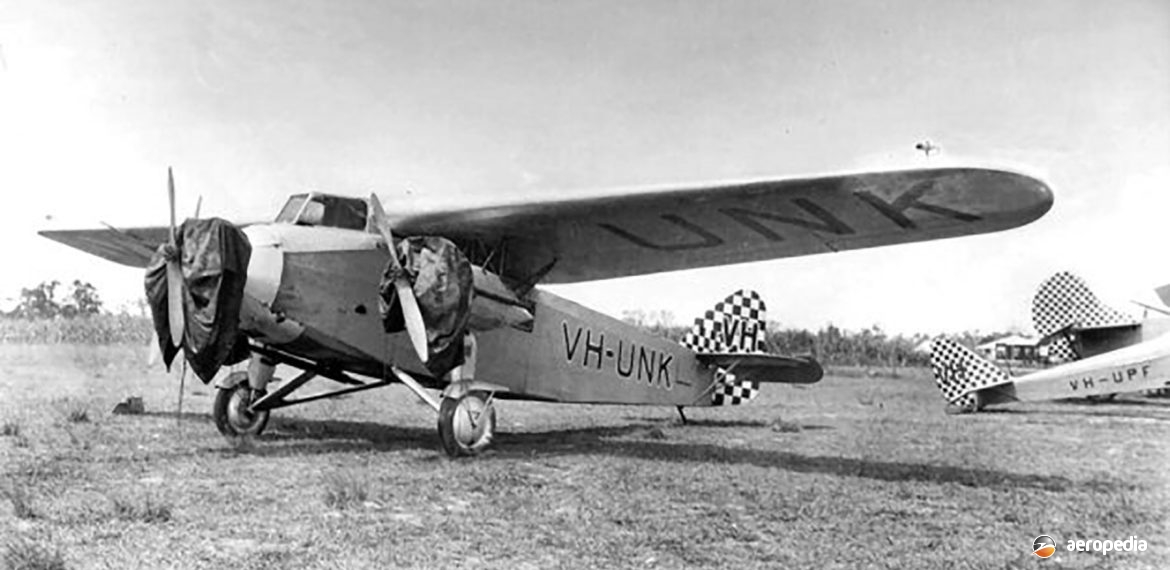Photograph:
Avro Five VH-UNK (c/n 370 – ‘Star of Cairns’) in the United Kingdom (A J Jackson collection)
Country of origin:
United Kingdom
Description:
Three-engine commercial airliner
Power Plant:
Three 78 kw (105 hp) Armstrong Siddeley Genet Major I five-cylinder air-cooled radial engines
Specifications:
- Wingspan: 14.32 m (47 ft)
- Length: 10.94 m (35 ft 9 in)
- Height: 2.89 m (9 ft 6 in)
- Wing area: 30.93 m² (333 sq ft)
- Max speed: 190 km/h (118 mph)
- Cruising speed: 153 km/h (95 mph)
- Initial rate of climb: 229 m/min (750 ft/min)
- Ceiling: 4,572 m (15,000 ft)
- Range: 644 km (400 miles)
- Empty weight: 1,266 kg (2,790 lb)
- Loaded weight: 2,005 kg (4,420 lb)
History:
The Avro 619 Five, of which only four were built, was a scaled down variant of the Avro Ten, the latter in itself being a licence-built variant of the Fokker F.VIIB/3m. Designed by well-known British aeroplane designer, Roy Chadwick, it had accommodation for a crew of two and five passengers. It was displayed at the July 1929 Olympia Aero Show in London. Construction was similar to the other Avro designs, with a wooden wing and fabric covered steel tube fuselage.
The first two aircraft were delivered in 1929 to Wilson Airways Ltd, which operated out of Nairobi in Kenya, these being VP-KAE (c/n 288) ‘Knight of the Grail’ and VP-KAD (c/n 426) ‘Knight Errant’.
Two examples saw service in the United Kingdom. The first G-AASO (c/n 383) was the manufacturer’s demonstrator which was entered in the Kings Cup Race in July 1930 but did not complete the course. It later went to Wilson Airways Ltd in Kenya as a third aircraft and was allotted the registration VP-KAH but this was never painted on the aircraft, it remaining in British markings until damaged beyond repair in a forced landing near Broken Hill, Northern Rhodesia on 18 January 1932. A second British machine G-ABBY (c/n 458) was operated by Air Service Training Ltd at Hamble in Hampshire, UK but was scrapped in March 1941.
One example was imported to this region as VH-UNK (c/n 370 – ‘Star of Cairns’) and was first registered to Queensland Air Navigation Ltd of Brisbane, QLD on 10 February 1930. This Company had offices in the T & C Building in Queen Street, Brisbane. The Avro Five was one of three Avro transports operated by the company, the otherw being Avro Tens VH-UNI (c/n 371 – Star of Townsville, and VH-UPI – c/n 468 – Star of Makay). The Avro Five was painted with a pale blue fuselage, silver wings and tailplanes with a black white chequered fin and rudder. The aircraft were based at Eagle Farm aerodrome.
Operations were to north Queensland cities as far as Townsville, and as far south as Grafton in New South Wales. Passengers, freight and mail were carried over the network but no subsidy was forthcoming from the Government at that time. At the time The Great Depression was rampant and the Company ran into financial difficulties. Senior officials from the Company travelled to Canberra in an attempt to obtain subsidies but to no avail.
However, the Avro Five only survived to 31 December 1930, New Years Eve, when it crashed on approach to Maryborough in Queensland and was destroyed, the pilot and passengers being killed. The aircraft was struck off the register on 27 January 1931. The Company ceased operations in January, 1931 and the remainder of its fleet was sold to New England Airways in 1932.

